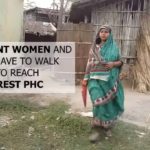A snoring health department in Dhanbad district was awoken from its three-year slumber of non-payment by Halima Ejaj, a soft-spoken woman in Jharkhand in March.
Under the Janani Suraksha Yojana, a mother having an institutional delivery in a government hospital is paid Rs. 1,400, while the Sahiya, the government appointed social health activist who monitors antenatal check-up, and the post-delivery care, is entitled Rs. 600.
But the Baghmara health department had not paid the new mothers and Sahiyas under this programme for more than three years. Halima, a health worker herself, made a video on the issue. Her video report shows the blatant negligence of the health officials. "I delivered my baby in a government hospital but even nine months after the delivery, I am still waiting to be compensated. I won't deliver in a government hospital again," says Usha Devi.
Janani Suraksha Yojana is a safe motherhood intervention under the National Rural Health Mission (NRHM) being implemented with the objective of reducing maternal and neo-natal mortality by promoting institutional delivery among the poor pregnant women to reduce the country's maternal and infant mortality rates.
Armed with the report, Halima visited the Baghmara Block Medical Officer and showed him her ground report. Upon investigation, he ordered that all the arrears be clearer by cheque at the soonest. Sahiyas who had arrears of at least three years finally were paid their due, along with the new mothers. "I have deposited this money under my daughter's name," said one happy mother, hopeful of her daughter's future.
The BDO explains, " It takes time for reports to come from Health Centres and additional health centres. And there are incidences of false reporting too. This hinders us to carry out our work efficiently."
However, a breakdown of the administrative responsibility and accountability brings the purpose of saving lives of many expectant and new mothers. Maternal mortality rate (MMR) in Jharkhand is 261 deaths per one lakh live births, which is much higher than the national average of 212 deaths. 41 children out of 1000, born in Jharkhand, don't live to see a tomorrow. But women like Halima Ejaj who are dedicated to demanding better accountability and responsibilities from their district's government officials to ensure a safe, just and equal society through the power of media.
This video was made by a Video Volunteers Community Correspondent Halima Ejaj.
Community Correspondents come from marginalised communities in India and produce videos on unreported stories. These stories are ’news by those who live it.’ They give the hyperlocal context to global human rights and development challenges.
See more such videos at www.videovolunteers.org. Take action for a more just global media by sharing their videos and joining in their call for change.
A bridge about to collapse in Bihar
The bridge that was built by the British is slowly chipping off, and fatal accidents are a regular occurrence there. The villagers along with our Community Correspondent are requesting the Government officials to repair this bridge. They are getting assurance that the repair work will start soon though it...
The Positive Changes in a Primary Health Centre
The positive changes in one of the Primary Health Centre (PHC) in Ramgarh District is encouraging.

